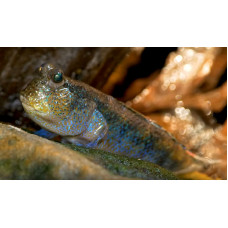Latin name
Periophthalmus barbarus
Other name
Periophthalmus barbarus
Identification
An air-breathing amphibian. Eyes - High set, close together; this species, like all fish, cannot blink due to the absence of eyelids, but sometimes retracts the eye into the eye socket with such rapidity that it gives the impression of blinking. The mouth is horizontal and coarse, with a skin fold overhanging the upper lip. The anterior nostrils are conical and tubular, reaching to the level of the lower lip. The posterior nostrils are small and slit. The snout is deep. Upper margin of gill, preoperculum and sub/infraorbital regions, and base of pectoral fins covered with small cycloid scales; 86-107 scales in longitudinal row (including usually 3 or 4 scales at base of caudal fin).
Features of fish fins
Dorsal spines (total): 11 - 15; Dorsal soft rays (total): 10 - 13; Anal spines: 1; Anal soft rays: 8 - 10.
First dorsal fin high, with 10-14 soft rays. Second dorsal fin with 1 apex and 10-13 soft rays, its base longer than the distance from the end to the beginning of the caudal fin, length of the base of the 2nd dorsal fin 20.9-24.1% SL). The length of the base of the anal fin is 14.1-17.7% SL. Pectoral fins with long muscular blade. The pelvic fins are joined by a transverse ligament that connects the bases of the 5th pair of segmented rays. The length of the pelvic fin is 14.2-16.0% of the mean; the frenulum connecting the pelvic fins is absent. The caudal fin is asymmetrical, the upper ray is longest, the lower rays are shorter and thicker.
Fish colouring
In live fish, the back is olive green or rusty brown, the belly is lighter; small blue eyes are scattered on the sides and back, and several oblique black stripes may be present on the dorsal sides. The 1st dorsal fin is dark along the anterior margin and has a light blue longitudinal stripe near the distal margin; the 2nd dorsal fin has 2 narrow bluish-white longitudinal stripes in the upper half. Anal fin pale or white, sometimes slightly mottled with small dark spots. Pectoral fins dark on outer (lateral) surface, with pale distal margins and lighter on inner surface, especially pelvic; pelvic fins whitish on pelvic surface, but darker on dorsal surface, with pale margins; caudal fin dark.
Distribution
Widespread in the tropics of West Africa, from Senegal to Angola.
Habitat
A marine, tropical, amphidromous, reef-dwelling species. Lives in both fresh and salt water. Prefers mangroves.
Size
Have a length of 14.5-16.5 centimeters. The width of the head is 15.4-21.8% of the width.
Behavior
The body of the Atlantic mudskipper is elongated, with two clearly divided dorsal fins and muscular pectoral fins, with the help of which it can jump, move on land, and the height of the jump can reach 60 centimeters.
Food and feeding habits
Adults feed mainly on arthropods (crabs, insects, etc.) that live on the surface of the mud. The diet also includes the white mangrove algae Avicennia nitida.
Reproduction
They lay their eggs in burrows. Atlantic mudskippers will not breed in the aquarium.
Fishing
Subsistence fishing.
Relationship with a person
Harmless. In captivity, these fish can only be kept as individuals, as they are extremely aggressive towards other fish. They are eaten as food by local residents.
| Classification | |
| Phylum | Chordata |
| Class | Actinopterygii |
| Squad | Gobiiformes |
| Family | Oxudercidae |
| Genus | Periophthalmus |
| Species | P. barbarus |
| Features | |
| Conservation status | Least Concern |
| Habitat | Pelagic |
| Life span, years | No information |
| Maximum body weight, kg | No information |
| Maximum length, cm | 16,5 |
| Sailing speed, m/s | No information |
| Threat to people | Edible |
| Way of eating | Planktonophage |
Atlantic mudskipper
Tags: atlantic mudskipper



